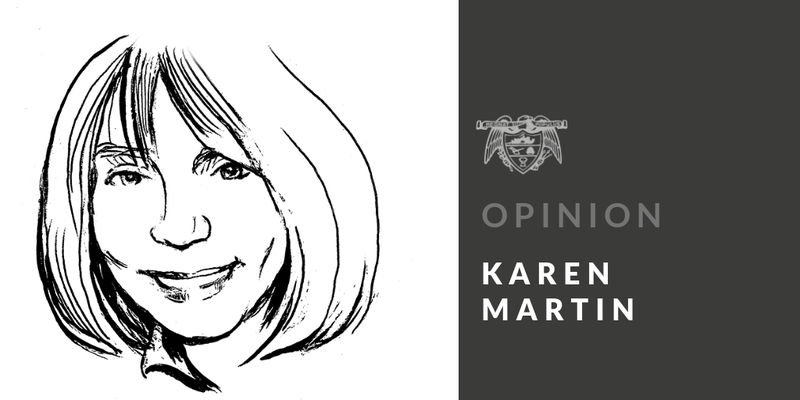It was a Tuesday in June, extraordinary only in the surprising coolness of the afternoon. We were working from home. Philip finished and headed out the door on a break, to enjoy the weather on his bike. I wrapped up editing a Perspective cover story then wandered into the kitchen to see what might be available for lunch.
About 20 minutes later, I heard the garage door open. That's weird, I thought. He usually rides longer than that. Opening the door to the garage, I saw why he was back. His face was covered with blood that was coming from a sizable gash on his forehead. He looked pretty distressed.
"Did you fall?" I asked, stating the obvious. He nodded, and I bolted back into the house to get towels, bandages, disinfectants; whatever I could grab.
A closer inspection told me that we wouldn't be able to get away with taping the cut shut and figuring it would heal on its own (bicycle riders do this a lot). We were going to have to seek medical attention. So I called our primary physician and asked if I could bring Philip in.
Nope, the nurse said, not unkindly. We don't do stitches, especially on the face. Go to an ER; they might be able to use glue to close the wound.
Uh-oh. I saw my afternoon routine of editing and reading proofs dissolve in a heartbeat. "Maybe we can go to an urgent-care and get this fixed," I suggested while trying to help him clean up and stanch the blood flow.
We grabbed a couple of books to keep us busy if necessary while waiting, gave the dogs some rawhide chews, and headed to the closest facility we could find, which required calling from outside its door to deliver a load of information. Then, masked, we entered, credit card extended. Two staff members took one look at the cut and said nope, we don't do facial stitches. You need to go to an ER.
That's what my primary care physician told me, but didn't metion why.
The urgent-care staff members gave us directions to a nearby hospital in Sherwood: "It's small, and you probably won't have to wait too long." We entered, consulted with a triage nurse, then took seats in the ER waiting room occupied by about 10 others.
That's when time commenced to stand still. Being bloody isn't the same as being in dire straits. And we soon learned that in the ER, you may not be seen in the order that you show up, but on the basis of how sick you are. Philip was mobile; he told the triage nurse his pain level was 3 out of 10 (big mistake), vital signs were OK, and exhibited no apparent distress other than dripping blood.
According to HowStuffWorks.com, patient priority is determined by a triage staff upon arrival at the ER. Symptoms are assessed and a medical history is assembled. Those with the most critical injuries or symptoms, such as patients with multiple traumas, are seen immediately.
Next there are patients with urgent symptoms that could deteriorate quickly into an emergency. Those with semi-urgent symptoms are generally seen within a couple of hours. Non-urgent patients could wait as long as two hours or more.
Slowing matters down even further are patients seeking routine medical care--considered non-urgent--that is available elsewhere. Examples of such seemed in abundance in the waiting room during our time there.
So after being handed a wad of gauze to catch blood drips, we were resigned to reading our books, watching Lifetime TV (not recommended), and trying not to go crazy. We sat there for four hours. What else could we do? We'd run out of options.
Being antsy, I wandered outside a few times to walk around the hospital complex. Philip didn't dare, lest they call him the minute he left the room.
Eventually, during my third walk around the parking lot (more interesting than the Lifetime TV; I got to check out a lot of nice cars), Philip was summoned to the so-called Fast Track ER. This involved conversations with several medical professionals, a trip to the CT scan room to ensure he hadn't broken his skull, the strapping-on of a neck restraint which was immediately removed by the next medical professional who entered the exam room, and finally the actual stitching and gluing of the forehead gash.
This was followed by more waiting in order to pass muster with the supervisor in charge of the proceedings, then with the handing-over of care instructions and a couple of prescriptions (one for nausea, which Philip didn't have, and one for hydrocodone with acetaminophen, although he wasn't suffering from any pain other than soreness).
We got home too late for me to attend my monthly book club gathering, which I regretted because for once I had read the entire book and would have been able to make a few decent contributions to the group discussion. We took photos of Phil's injuries and shared them with co-workers in a virtue-signaling plea for sympathy (although journalists are a hard crowd for such efforts).
The bike will recover, although the handlebars are at a strange angle and will need some adjustments. After a shower, a generous dose of bourbon, some dinner and ibuprofen, Philip felt better. I haven't gotten over missing my book-club friends, but there's always next month.
Now we're waiting for the hospital bill. And wondering why there isn't a better system for handling a situation like this one.
Karen Martin is senior editor of Perspective.
kmartin@arkansasonline.com
